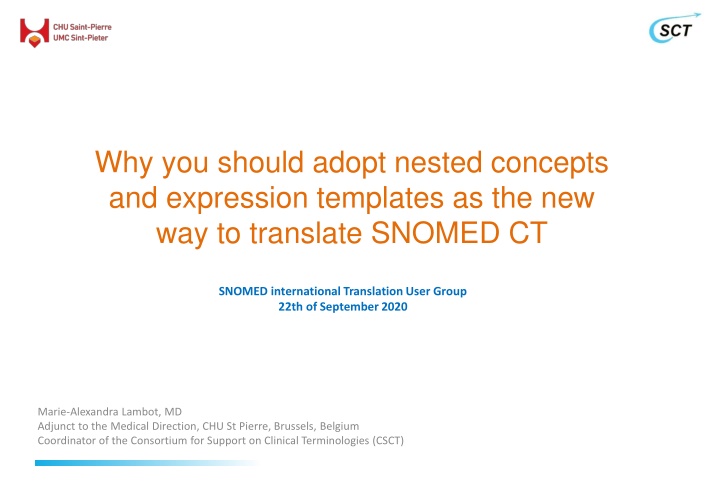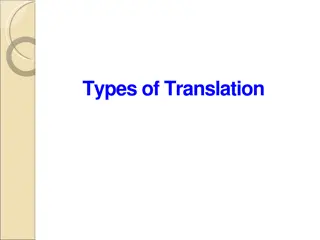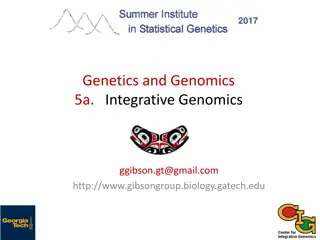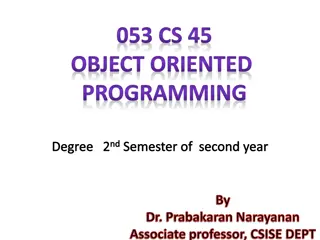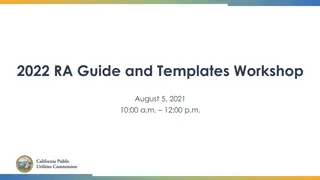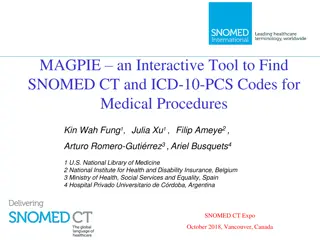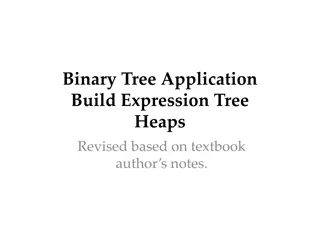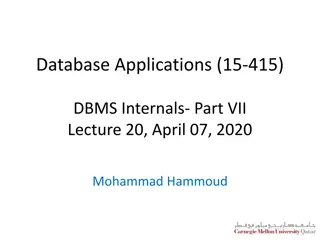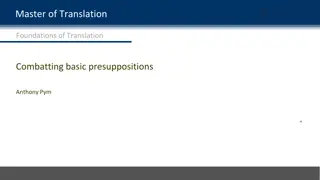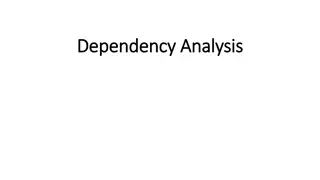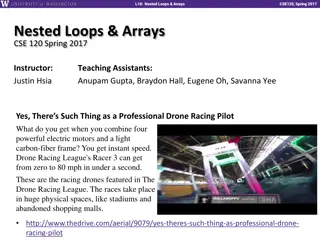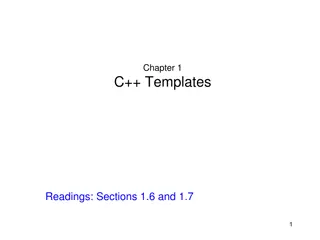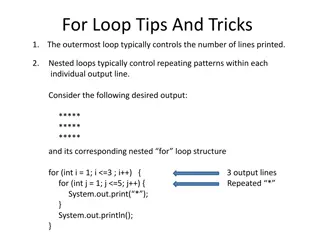Transforming SNOMED CT Translation with Nested Concepts and Expression Templates
Adopting nested concepts and expression templates revolutionizes SNOMED CT translation, offering a more structured approach that streamlines the process from selection to standardization, enhancing accuracy and efficiency significantly.
Download Presentation

Please find below an Image/Link to download the presentation.
The content on the website is provided AS IS for your information and personal use only. It may not be sold, licensed, or shared on other websites without obtaining consent from the author.If you encounter any issues during the download, it is possible that the publisher has removed the file from their server.
You are allowed to download the files provided on this website for personal or commercial use, subject to the condition that they are used lawfully. All files are the property of their respective owners.
The content on the website is provided AS IS for your information and personal use only. It may not be sold, licensed, or shared on other websites without obtaining consent from the author.
E N D
Presentation Transcript
Why you should adopt nested concepts and expression templates as the new way to translate SNOMED CT SNOMED international Translation User Group 22th of September 2020 Marie-Alexandra Lambot, MD Adjunct to the Medical Direction, CHU St Pierre, Brussels, Belgium Coordinator of the Consortium for Support on Clinical Terminologies (CSCT)
The classical "recommanded" way of translating SNOMED CT Translation guidelines Selection of the subset to translate NRC Meaning based translation by reviewer 1 Meaning based translation by reviewer 2 either in parallel or sequencial Domain experts Reconciliation by a "judge" of the differences if there is a discordance between the two reviewers Linguistic quality controls Technical controls NRC
The classical "recommanded" way of translating SNOMED CT Translation guidelines Selection of the subset to translate NRC EMPTY Meaning based translation by reviewer 1 Meaning based translation by reviewer 2 either in parallel or sequencial Domain experts Reconciliation by a "judge" of the differences if there is a discordance between the two reviewers Linguistic quality controls Technical controls NRC
The empty gap in the classical translation method No guideline about structured preparation of the translator's work using for example automatical lexical based translations Each concept is translated by itself no guidelines about translating concepts by "family" (branch of subhierarchy) no recommandation to refer to a "canonical" translation of its attributes - value pairs no recommandation to refer to the translation of the "nested concepts that might be contained in the FSN of the concept to be translated The systematic standardisation of the reviewer's work happens (if any) "at the tail", after the domain experts' work and is mainly of linguistic nature Why try to chase the tail of the beast when you could steer it much better by starting standardization at the head?
Lexical based pretranslation Method invented by Dr Michel Walravens Parse the FSNs into single "lexical units" = words, digits or punctuation marks Translate each of these units in a lexicon in two steps: Google pretranslation Validation of the translation(s) by experts with regard to the context of the FSNs these concepts will be used into Eventually group words that appear systematically together in the lexicon as "multiwords"/"word group" lexical entries Produce a lexicon-based automated pretranslation using programmed grammatical rules
The notion of "nested concepts" A lexical-based translation is good method to speed up the translation process and offer some basic level of standardization to the translators But we can do much better because some words or word groups ("multiwords") in the lexicon are in fact SNOMED CT concepts themselves Example:429224003 | Acute renal failure due to acute cortical necrosis (disorder) |
Nested-based translation Consists in first running the FSNs of the subset to be translated against the international Edition to identify the nested concepts then to Translate the "root" nested concepts as a pre-required sub-project, following the usual translation best practice for SNOMED CT concepts Translate the words that are not SNOMED CT nested concepts/word groups as in the classical lexical approach Proceed with either manual "recomposition" or the more precoordinated concepts to be translated by the translators or offer them advanced lexical- nested-based pretranslations to judge Note that while this process is described here on FSN since those are the "source of truth" it could be applied to the English international acceptable synonyms too to offer more suggestions to the translators.
Nested-based translation Offers a higher quality of pretranslations to start with for the domain experts Higher standardization inside concept family groups at pretranslation level but the authors can still refuse to take these suggestions into account Does not guarantee standardization of the structure of the term "sentence" Quality can be severly affected by the (lack of) quality of the programmation of the grammatical reconstruction algorythm
Translation templates Inspired by SNOMED international editorial templates for concepts but taking into account the specific problems related to translation Aims to offer a standard "sentence" construction and similar terms for families of concepts, taking into account the previous translation of root- words, root-nested concepts and less precoodinated concepts of the same family Gives rules on the default choice of the PT (may be changed on a case by cas basis if the clinical usage prefers another term) and the default synonymes to be added (may be omitted on a case by case basis if they turn out to be linguistically correct but artificial for clinicians) Can either be built "as you go" from the suggestions of the reviewers 1 as they stumble on recurrent patterns in concepts they translate or be the subject of a specific preparation work on subhierarchies or on concepts using specific attributes or a mix of both.
Top down translation template example (1) Root concept translation: 39607008 |Lung structure (body structure)| => poumon, structure pulmonaire 7771000 |Left (qualifier value)| 24028007 |Right (qualifier value)| => droit => gauche [laterality] [lat ralit ] => 44029006 |Left lung structure (body structure)| 3341006 |Right lung structure (body structure)| Template BS-0001: " structure of [localization] lobe of [laterality] lung " [localization] values= (empty), upper, middle, lower 264217000 |Superior (qualifier value)| => sup rieur 260528009 |Median (qualifier value) | => moyen 261089000 |Inferior (qualifier value)| [position] => inf rieur PT: Ps-FSN: " structure du lobe [position] du poumon [lat ralit ] " Syn 2: " lobe pulmonaire [position] [lat ralit ] " " lobe [position] du poumon [lat ralit ] "
Top down translation template example (2) Template BS-0004: " structure of [localization2] segment of [localization] lobe of [laterality] lung " BS-0001 [laterality] values = (empty), right, left [localization] values= (empty), lower, middel, upper [localization2] values= (empty), apical, subapical, lateral, . PT: " segment [localisation Nouvelle Nomenlclature] du lobe [position] du poumon [lat ralit ] " (Med acad) Ps-FSN: " structure du segment [localisation Nouvelle Nomenlclature] du lobe [position] du poumon [lat ralit ] " Syn 2: " segment [localisation ancienne nomenclature] du lobe [position] du poumon [lat ralit ] " (Med acad) Syn 3: " segment [num ro en chiffre romains] du poumon [lat ralit ] " Syn 4: " terme latin venant de la Terminologia Anatomica " + en remarque: "latin TA [nr de TA] " Syn 5: " segment [localisation] du lobe (pulmonaire) [position] [lat ralit ] "
Top down translation template example (3) 20218002 | Structure of middle lobe lateral segmental bronchus of right lung (body structure) | Template BS-0008: " structure of [localization] lobe [localization2] segmental bronchus of [laterality] lung " BS-0004 Root concept translation: 955009 |Bronchial structure (body structure)| PT: " bronche segmentaire [localisation Nouvelle Nomenlclature] de la bronche lobaire [position][lat ralit ] " (acad mie de m decine) Ps-FSN: " structure de la bronche segmentaire [localisation Nouvelle Nomenlclature] de la bronche lobaire [localisation Nouvelle Nomenlclature] " Syn 2: " bronche segmentaire [localisation ancienne nomenclature] de la bronche lobaire [position][lat ralit ] " (acad mie de m decine) Syn 3: " bronche segmentaire [localisation] du lobe [position][lat ralit ] " Syn 4: " bronche du segment [num ro en chiffre romains] du poumon [lat ralit ] " Syn 5: " terme latin venant de la Terminologia Anatomica" + en remarque "latin TA [nr de TA] " Syn 6: optionnel, pour un autre synonyme ancien sur le mod le du Syn 2 ou s'il existe une d nomination utilisant un ponyme (ex: bronche de Nelson du lobe inf rieur gauche)
Organizing templates Quickly the need to keep track of template dependencies arise to Know what you have, what you can/must base you upon Know what you need to update if you add or modify a given template
Organizing templates: Two aspects to consider 1. Keeping track of templates in Excel or Jira is quickly inefficient then useless. There a just too may of them with too many dependences. But what is a template exactly? - Templates are a simplified representation of the SNOMED CT terminology. - If the FSN are unambiguous and well crafted, dependencies between templates mirror of relationships between concepts - Templates differ from concepts only by the fact they use "wild cards" representing simple value sets of concepts for the variable parts of the term => What is needed is a hierarchy of templates + their allowed value sets 2. You would want to keep also a link between the template and every concept it is used for so you can quickly pinpoint which concept translations need updating should you find a flaw with a template
Link between the descriptions and their translation templates language refset FR* (CTS) Translation template association refset (CTS) descritptions FR* (CTS) Plural to singular link refset FR**(CTS) 1..1 Preferred Fully Specified Name (EN) 1..1 0..n Preferred acceptable synonyme FR Translation template row id 0..n Translation template row id Preferred acceptable synonyme FR-plural Concept SCTID 0..1 0..n 0..n Translation template row id Acceptable synonyme FR 0..n Translation template row id Acceptable synonyme FR -plural 0..1 0..n 0..n Acceptable interface term FR Translation template row id 0..n Translation template row id Acceptable interface term FR-plural 0..1 A translation template is linked to the concept it is applied to while a translation template row is linked directly to the description that arise from it.
Description translation template association refset structure Links the description in a given language to the translation template used to create this descritpion in this language. Note that this method is applicable also to the SNOMED international english templates currently lying scattered in the authoring guide, on various confluence pages and in Jira. iD Effective time Active Module ID refsetID referencedComponentID targetComponentID UUID date integrer SCTID SCTID SCTID SCTID Translation template association refset description ID Translation template row id In order to do this, we need to create template concepts and template row concepts and make an association between the translation concept and its rows.
Translation template description file Template rows are probably best viewed as "descriptions of a translation concept not as concepts themselves. So it's not so much an association refset but more technically a template description file that should be used to represent template rows and associat them with thamplate concepts. Template BS-0003 Template X Concept structure of bronchus of [laterality] [localization] lobe Template X row1 bronche lobaire [localisation Nouvelle Nomenlclature] Template X row2 structure de la bronche lobaire [localisation Nouvelle Nomenlclature] Template X row3 Template X row4 bronche lobaire [localisation ancienne Nomenlclature] bronche du lobe [position] du poumon [lat ralit ]
Template relationship file Dependencies between templates can be represented by "is a" relationships between template concepts. BS-0001 | structure of [localization] lobe of [laterality] lung | is a is a is a BS-0004| structure of [localization] segment of [localization2] lobe of [laterality] lung BS-0003 | structure of bronchus of [laterality] [localization] lobe | BS-0005| segmental bronchus of [localization] lobe of [laterality] lung is a BS-0008 | structure of [localization2] lobe [localization] segmental bronchus of [laterality] lung | This creates a "backbone" hierarchy of templates concepts mirroring the "true" precise medical SNOMED CT hierarchy.
Template relationship file It is like having a "simplified" version of the terminology with [ wild cards ] that can be represented as simple refsets. BS-0001 | structure of [localization] lobe of [laterality] lung | right middle is a [localization]= empty BS-0004| structure of [localization2] segment of [localization] lobe of [laterality] lung [localization2]= lateral is a [localization]= empty middle BS-0008 | structure of [localization2] lobe [localization] segmental bronchus of [laterality] lung | lateral right value set laterality = empty, right, left. value set localization = empty, superior, middle, inferior. value set localization2: empty, lateral, medial, anterior, apical, posterior, subapical, apicoposterior, superior.
Translation template rows association refset structure Links the clincial concept descriptions to their translation templates. iD Effective time Active Module ID refset ID referenced ComponentID target Component ID Template language UUID date integrer SCTID SCTID SCTID SCTID text Tr. Templ. Row Ass. Refset translation template concept SCTID Translation template row SCTID code de langue au format iso Translation template acceptability Obligation status of the description translation Y/N Singular/plural status Singular parent ID SCTID integrer SCTID SCTID translation template default acceptability 0/1 plural form Description ID of the singular term it is the plural of Translation template Template language/dialect FR structure of bronchiole of [localization] lobe of [laterality] lung bronchiole du lobe [localisation] du poumon [lat ralit ] Preferred term 1 Terme singulier structure d'une bronchiole du lobe [localisation] du poumon [lat ralit ] Pseudo-FSN 1 Terme singulier bronchioles du lobe [localisation] du poumon [lat ralit ] SCTID 1 Terme pluriel Acceptable synonym Template rows Plural status Row acceptability Description row obligation Singluar parent
Translation template row values association refset structure Linking the chosen value from the value set for each of the wild card(s) might be interesting too. Representation of the values might be done with a refset looking like this iD Effective time Active Module ID refset ID referenced ComponentID target value set UUID date integrer SCTID SCTID SCTID SCTID Tr. Templ. Values Ass. Refset Translation template row SCTID SCTID of the refset used in the template value type Value Value language SCTID / text text/SCTID text SCT concept or non-SCT word Term if it is a non SCT concept. SCTID of the descrition in the translation language code de langue au format iso Template row bronche segmentaire [localisation2] de la bronche lobaire [localisation][lat ralit ] Important for the non-SCTID who are not linked to a language refset like the SCTdescriptions [Localisation2 refset] FR "apicale" Text [Localisation refset] SCTID description FR "inf rieure" SCTID FR SCTID SCTID description FR "gauche" FR [Laterality refset ] Value type Value Value language Target value set
Translation templates creation process Start by the root / nested concept(s) of the subfamily Let a first author work on a few concepts of the subfamily and propose the template(s) Submit the template(s) to another author and have him apply the template(s) to other concepts of the subfamily to see if it (they) fit(s) Put the authors together to modify the template(s) according to the remarks if any Have the authors apply the template(s) to all the subfamily If any additional remarks arise, modify the template(s) and re-apply the modified template(s) to all the subfamily Storage of the templates/values used in each term should be linked immediately to the term while authoring it, thanks to an adequate tooling interface
Conclusion The creation of translation templates: Help standardize SNOMED CT description terms in non-Core languages Takes more preparation time but speeds up the translation process itself once the templates are in place Imposes a real thorough comprehension of the concept, its relation AND exploration of its family => less risk the author will do a lexical translation without fully understanding the concept Help pinpoint the current errors in the structure of FSNs and synonyms so the work on non-Core templates should always refer to current SCT authoring templates when available and ideally should be linked to a reporting system/correction system of the English descriptions Proposes a way to store the Core authoring templates currently scattered in the authoring guide, confluence and Jira as a SCT file format that can be distributed with the International Edition and used in authoring tools
Conclusion Further work is needed to evaluate if creating a "SNOMED CT Edition of templates" containing template concepts, descriptions and relationships, however over-ambitous this may sound at first, wouldn't be the most logical and best approach to template storage if we want to move toward a higher standardization of the SNOMED CT terms, in whatever language they come.
Thanks for your attention @ Belgian Consortium for Support on Clinical Terminologies https://csct.be contact: info@csct.be
